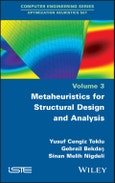Metaheuristics for Structural Design and Analysis discusses general properties and types of metaheuristic techniques, basic principles of topology, shape and size optimization of structures, and applications of metaheuristic algorithms in solving structural design problems. Analysis of structures using metaheuristic algorithms is also discussed. Comparisons are made with classical methods and modern computational methods through metaheuristic algorithms. The book is designed for senior structural engineering students, graduate students, academicians and practitioners.
Table of Contents
Preface ix
Introduction xi
Chapter 1 Evolution of Structural Analysis and Design 1
1.1 History of design 2
1.2 From empirical rules and intuition to FEM 6
1.3 From FEM to AI 8
Chapter 2 Metaheuristic Algorithms 11
2.1 A brief history of the development of metaheuristic algorithms 12
2.2 Generalities about metaheuristic algorithms 14
2.3 Evolutionary algorithms 17
2.3.1 Genetic algorithms 17
2.3.2 The differential evolution algorithm 18
2.4 Swarm intelligence 19
2.4.1 Particle swarm optimization 20
2.4.2 The flower pollination algorithm 22
2.4.3 The bat algorithm 23
2.5 Other metaheuristic algorithms 24
2.5.1 Simulated annealing 24
2.5.2 Teaching-learning-based optimization 26
2.5.3 Harmony search 27
2.5.4 The Jaya algorithm 28
Chapter 3 Application of Metaheuristic Algorithms to Structural Problems 31
3.1 Objective function 32
3.1.1 Weight 32
3.1.2 Cost 33
3.1.3 Response 35
3.1.4 Effectiveness 37
3.1.5 CO2 emissions in construction 38
3.2 The design constraints 38
3.2.1 Stress 40
3.2.2 Deformations 43
3.2.3 Buckling 45
3.2.4 Fatigue 46
3.2.5 Design regulation rules 46
Chapter 4 Applications of Metaheuristic Algorithms in Structural Design 49
4.1 Generalities in structural design 49
4.2 Sensibility analyses and reliability 50
4.3 Types of structural optimization 50
4.4 Basic structural engineering applications 52
4.4.1 Vertical deflection minimization problem of an I-beam 52
4.4.2 Cost optimization of the tubular column under compressive load 56
4.4.3 Weight optimization of cantilever beams 60
4.5 Appendix 1 63
4.6 Appendix 2 66
4.7 Appendix 3 69
Chapter 5 Optimization of Truss-like Structures 75
5.1 The optimum design of truss structures 75
5.1.1 Analyses of truss structures 76
5.1.2 Review of the literature on the optimization of truss structures 78
5.2 Numerical applications in the optimization of truss structures 79
5.2.1 A 5-bar truss structure optimization problem 79
5.2.2 A 3-bar truss structure optimization problem 82
5.2.3 A 25-bar truss structure optimization problem 85
5.2.4 A 72-bar space truss optimization example 88
5.2.5 A 200-bar planar truss optimization example 89
5.3 Tensegrity structures 93
5.4 Appendix 1 94
5.5 Appendix 2 97
Chapter 6 Optimization of Structures and Members 101
6.1 Optimum design of RC beams 102
6.2 Optimum design of RC spread footings 112
6.3 Optimum design of RC columns 118
6.4 Optimum design of RC frames 126
6.4.1 The first example: two-span two-story RC frame 132
6.4.2 The first example: two-span two-story RC frame 133
6.5 Optimum design of RC cylindrical walls 136
6.5.1 Optimum design of axially symmetric RC walls 136
6.5.2 Optimization of post-tensioning forces for cylindrical walls 138
6.5.3 Optimization of post-tensioned axially symmetric cylindrical RC walls 141
Chapter 7 Optimization in Structural Control Problems 143
7.1 Optimum design of tuned mass dampers (TMD) 144
7.1.1 Time domain-based optimization of TMDs 147
7.1.2 Frequency domain-based optimization of TMDs 152
7.2 Optimum design of base isolation systems 174
Chapter 8 Applications of Metaheuristic Algorithms to Structural Analysis 181
8.1 Fundamentals of the method 181
8.2 Applications to structures, generalities 185
8.3 Applications to trusses and truss-like structures 185
8.4 Applications to plates 189
8.5 Further studies on the analysis of structures with TPO/MA 193
Future Trends 195
References 199
Index 217








